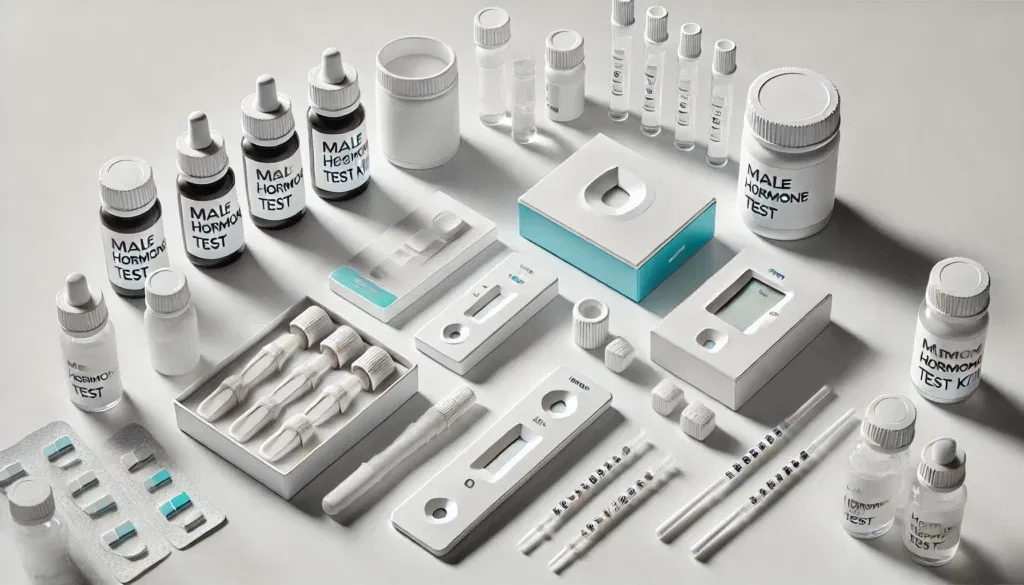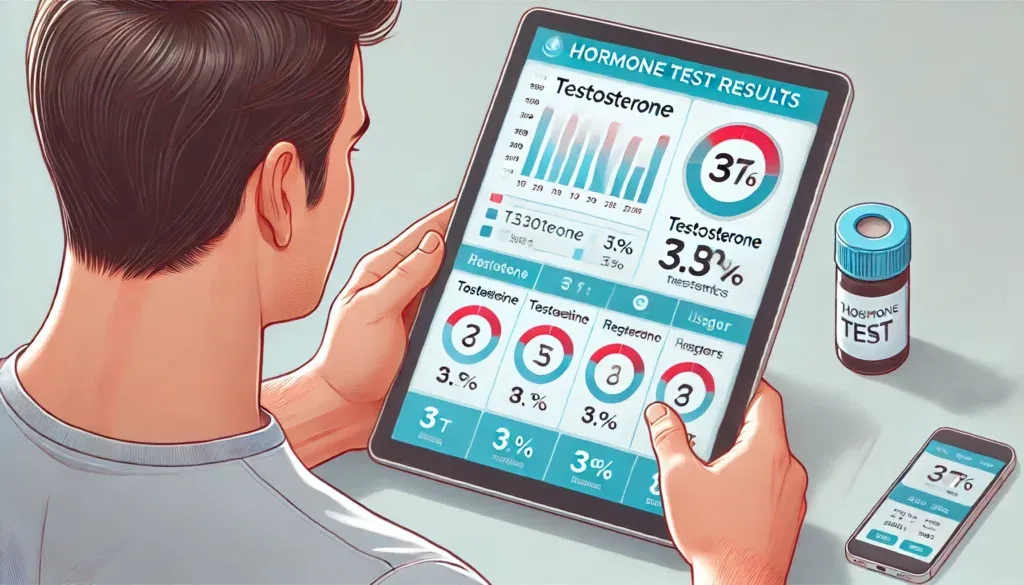Understanding Male Hormone Test Kits and Their Importance
Hormones play a crucial role in regulating various bodily functions, including metabolism, mood, energy levels, muscle growth, and reproductive health. For men, testosterone is the most significant hormone, influencing physical development, libido, and overall well-being. However, fluctuations or imbalances in testosterone and other essential hormones can lead to a range of health issues, including fatigue, depression, reduced muscle mass, and erectile dysfunction.
You may also like: How to Get Your Testosterone Levels Checked: Best At-Home and Lab Testing Options
Male hormone test kits provide a convenient and accessible way to assess hormone levels without requiring a visit to a medical professional. These at-home testing solutions allow men to monitor their testosterone and other hormone levels, helping them detect imbalances early and make informed health decisions. With the rising popularity of home health diagnostics, hormone test kits for men have become a reliable tool for those seeking greater control over their health.
Given the increasing interest in optimizing testosterone levels and hormone health, understanding how these test kits work, what they measure, and their reliability is essential. In this comprehensive guide, we will explore the different types of male hormone test kits, the process of using them, and how to interpret the results effectively.

How Do Male Hormone Test Kits Work?
Male hormone test kits typically involve collecting a biological sample—saliva, blood, or urine—which is then analyzed in a certified laboratory. These kits are designed to measure various hormones, including testosterone, dihydrotestosterone (DHT), estrogen, cortisol, and dehydroepiandrosterone (DHEA). Understanding what these hormones do and why they matter is vital in evaluating overall hormonal balance.
Testosterone, the primary male sex hormone, is responsible for muscle development, bone density, and reproductive health. DHT, a more potent derivative of testosterone, plays a significant role in hair growth and prostate health. Estrogen, though commonly associated with female health, is also essential for men, influencing mood, bone density, and cardiovascular function. Cortisol, the body’s stress hormone, impacts energy levels, metabolism, and immune function. DHEA, a precursor to both testosterone and estrogen, helps regulate overall hormone production and aging processes.
Different types of test kits utilize various methods for sample collection. Blood tests, often requiring a finger-prick sample, are considered highly accurate for measuring testosterone and other hormone levels. Saliva tests are non-invasive and useful for detecting free testosterone, the biologically active form of the hormone. Urine tests can offer insights into hormone metabolites and long-term trends in hormone levels.
Choosing the Right Male Hormone Test Kit
With numerous options available on the market, selecting the best hormone test for men depends on several factors, including the type of hormones being measured, accuracy, convenience, and cost. Some of the most popular at-home hormone test kits include:
- Everlywell Testosterone Test: This at-home testosterone checking kit uses a saliva sample to measure free testosterone levels, providing insights into how much active testosterone is circulating in the body. Many users appreciate its ease of use and detailed report.
- LetsGetChecked Male Hormone Panel: This complete male hormone test evaluates key hormones, including total testosterone, luteinizing hormone (LH), and prolactin. The finger-prick blood sample collection ensures accuracy and reliability.
- MyLAB Box Testosterone Home Test: This OTC testosterone test offers a straightforward approach for checking testosterone levels using a saliva sample, making it a convenient choice for men seeking quick results.
- ZRT Laboratory Male Hormone Panel: This comprehensive at-home hormone test for males analyzes multiple hormones, including testosterone, estradiol, progesterone, and cortisol, providing a detailed assessment of hormonal balance.
Choosing the right test kit requires considering personal health goals, budget, and the level of detail desired in hormone analysis. While some men may only need a basic testosterone kit, others may benefit from a full male hormone check to identify potential imbalances across multiple hormone markers.
How to Use a Male Hormone Test Kit Effectively
Using an at-home testosterone kit correctly is essential for obtaining accurate and reliable results. While specific instructions vary depending on the brand, most tests follow a general process:
- Read the Instructions Carefully: Each test kit comes with a detailed guide explaining how to collect and store the sample properly. Understanding these instructions before beginning ensures a smooth and error-free process.
- Choose the Right Time for Testing: Hormone levels fluctuate throughout the day, and testosterone levels are usually highest in the morning. For the most accurate results, it is recommended to collect the sample within the first few hours after waking up.
- Collect the Sample as Directed: Blood-based kits require a finger-prick sample, while saliva kits require spitting into a collection tube. Urine tests may require collecting multiple samples throughout the day.
- Store and Ship the Sample Properly: Most test kits provide a prepaid return envelope for sending the sample to a certified laboratory. Proper storage and timely shipping help ensure accurate analysis.
- Review and Interpret the Results: Once the laboratory processes the sample, results are typically available online within a few days. Understanding the normal reference ranges and identifying any abnormalities is crucial for taking appropriate action.
Interpreting Your Male Hormone Test Results
When reviewing male hormone test results, it is important to understand the reference ranges for each hormone. Normal testosterone levels in men generally range between 300 and 1,000 ng/dL, though individual variations may exist. Low testosterone levels (below 300 ng/dL) may indicate hypogonadism, a condition that can lead to reduced muscle mass, fatigue, and low libido.
Elevated estrogen levels in men may contribute to weight gain, mood swings, and gynecomastia (male breast tissue enlargement). High cortisol levels may indicate chronic stress, which can negatively impact testosterone production and overall well-being. Understanding these results allows men to make informed decisions about potential lifestyle changes, medical consultations, or supplementation.
Taking Action Based on Your Results
If an at-home hormone test reveals imbalances, several strategies can help restore hormonal equilibrium. Lifestyle changes, such as optimizing sleep, maintaining a healthy diet, managing stress, and engaging in regular exercise, can significantly improve hormone levels. Supplements like vitamin D, zinc, and ashwagandha have been shown to support testosterone production.
For men with clinically low testosterone, medical treatments such as testosterone replacement therapy (TRT) may be an option. Consulting a healthcare professional is essential before beginning any treatment to ensure safety and efficacy.

Frequently Asked Questions (FAQ) on Male Hormone Testing
1. What is the purpose of a male hormone test kit?
A male hormone test kit is designed to assess hormone levels, particularly testosterone and other key androgens, from a simple at-home sample collection. These kits help men monitor hormonal health, detect imbalances, and understand potential symptoms like fatigue, weight gain, or low libido. Using a male hormone test can provide valuable insights into metabolic function, energy levels, and even mental well-being. Many modern kits include a complete male hormone test that checks multiple biomarkers beyond testosterone, such as DHEA, cortisol, and estrogen. This broader approach allows for a more comprehensive male hormone check without requiring a doctor’s visit.
2. How does an at-home hormone test for men compare to a lab-based test?
An at-home hormone test for men offers convenience, privacy, and accessibility compared to traditional lab-based tests. While laboratory tests conducted by medical professionals may have a higher level of accuracy due to controlled conditions, at-home testosterone kits still provide highly reliable results when used correctly. Advances in technology have improved the sensitivity of saliva and blood spot tests, making them viable alternatives. Many at-home testosterone kits also include easy-to-follow instructions, pre-paid return shipping, and digital result analysis. However, if an abnormality is detected, follow-up with a healthcare provider for a full male hormone panel may be recommended.
3. What hormones are typically measured in a complete male hormone test?
A complete male hormone test typically includes testosterone (both free and total), DHEA-S, cortisol, estradiol (a form of estrogen), and sometimes luteinizing hormone (LH) and follicle-stimulating hormone (FSH). These markers provide insight into overall hormonal balance, adrenal function, and reproductive health. Checking testosterone levels alone does not always give the full picture, which is why a broader male hormone panel can be beneficial. Estradiol levels, for instance, can impact fat distribution and mood, while DHEA-S contributes to energy and immune function. Understanding these levels through a male hormone check can help address issues like weight management, mental clarity, and cardiovascular health.
4. How often should men use a testosterone checking kit?
The frequency of testosterone checking depends on individual health goals and symptoms. For men experiencing fatigue, low libido, or unexplained weight gain, testing every three to six months may be useful. Those who are undergoing testosterone replacement therapy (TRT) or hormone optimization programs should follow their doctor’s recommendations, which may require testing every one to two months. Even for men without symptoms, using a male hormone test kit annually can provide valuable insights into long-term health. Regular male hormone checks can help identify trends and ensure early intervention if hormone levels begin to decline.
5. Are over-the-counter (OTC) testosterone tests reliable?
OTC testosterone tests, such as those offered by Everlywell, are designed to provide a convenient way to monitor testosterone levels at home. While they are generally accurate, their reliability depends on proper sample collection and adherence to instructions. An otc testosterone test can be a good starting point for men curious about their hormone health, but results should always be interpreted in context. The Everlywell testosterone test review and similar products show that while they are useful for screening, a lab-confirmed male hormone panel may still be necessary for a definitive diagnosis. If an OTC testosterone test indicates low levels, consulting a healthcare provider for further evaluation is advisable.
6. Can diet and lifestyle changes affect hormone test results?
Yes, diet and lifestyle factors significantly influence hormone test results. High sugar intake, chronic stress, poor sleep, and lack of exercise can all contribute to hormonal imbalances. Conversely, a nutrient-dense diet rich in healthy fats, lean proteins, and antioxidants can support optimal testosterone levels. Before taking an at-home hormone test for men, it’s best to maintain consistent lifestyle habits for at least a few weeks to ensure accurate readings. Engaging in resistance training, reducing alcohol consumption, and managing stress through mindfulness can positively impact male hormone panel results over time.
7. How do Everlywell testosterone test reviews compare to other brands?
Everlywell testosterone test reviews highlight convenience, ease of use, and fast turnaround times as key benefits. Compared to other brands, Everlywell stands out for its comprehensive digital reporting and accessibility. However, some users have noted that results can be influenced by factors like hydration and time of day when the sample is collected. Other brands may offer additional biomarkers in their male hormone test kits, such as SHBG (sex hormone-binding globulin) or prolactin. For men looking for a complete male hormone test, comparing multiple brands can help identify the best option for their specific needs.
8. What symptoms indicate the need for a male hormone check?
Symptoms that may indicate the need for a male hormone check include fatigue, decreased muscle mass, unexplained weight gain, mood swings, and difficulty concentrating. Erectile dysfunction, low libido, and sleep disturbances can also be linked to hormonal imbalances. Since testosterone and other hormones regulate many physiological processes, even subtle symptoms can signal underlying issues. A male hormone test kit can help pinpoint whether hormone levels are within a healthy range or require intervention. If severe symptoms persist, consulting a healthcare provider for a full male hormone panel is recommended.
9. Are there any risks or limitations associated with at-home testosterone kits?
While at-home testosterone kits offer convenience, there are some limitations to consider. Factors like improper sample collection, time of day, and hydration levels can affect accuracy. Additionally, at-home hormone test male kits typically do not diagnose conditions; they provide preliminary data that may require further investigation. Some hormone fluctuations are normal, and a single test may not always reflect long-term trends. To mitigate these risks, following instructions carefully and conducting multiple tests over time can provide a more accurate assessment of male hormone balance.
10. What steps should be taken if a male hormone panel shows abnormal results?
If a male hormone panel reveals abnormal results, the first step is to consult a healthcare provider for further evaluation. They may recommend additional testing, such as bloodwork conducted in a clinical setting, to confirm findings. Lifestyle modifications, dietary changes, and medical treatments may be suggested based on the specific hormonal imbalance. In some cases, hormone replacement therapy or targeted supplementation can help restore optimal levels. Tracking changes with periodic male hormone checks can also provide insight into the effectiveness of any interventions.

Conclusion: Empowering Men to Take Control of Their Hormonal Health
Male hormone test kits provide a powerful tool for men looking to take charge of their health. By offering a convenient way to check testosterone and other hormone levels at home, these kits enable early detection of imbalances and allow for proactive health management. Understanding how these tests work, how to use them correctly, and how to interpret results empowers men to make informed decisions about their well-being. Whether for routine monitoring or addressing specific concerns, at-home hormone testing is a valuable resource in optimizing men’s health and longevity.
male hormone imbalance symptoms, hormone health for men, testosterone deficiency in men, how to increase testosterone naturally, male hormonal balance, at-home testosterone testing, best testosterone supplements, testosterone replacement therapy options, natural ways to boost testosterone, hormone test accuracy, men’s health supplements, cortisol and testosterone relationship, DHT levels in men, how to lower estrogen in men, hormonal optimization for men, testosterone and muscle growth, signs of low testosterone, hormone panel for men, male fertility and hormones, biohacking testosterone levels
Further Reading:
Are Routine Testosterone Assays Good Enough?
Male hormones: A guide on hormone health for men
Disclaimer: The information provided in this article is for general informational purposes only. The content does not constitute professional advice of any kind, including but not limited to medical, legal, or financial advice. HisHealthMag and its contributors make no representations or warranties regarding the accuracy, completeness, or reliability of the information presented. Always seek the advice of a qualified professional for any specific concerns or questions you may have. Neither HisHealthMag nor its authors assume any responsibility or liability for any actions taken based on the information provided in this article. The views and opinions expressed are those of the author(s) and do not necessarily reflect the official policy or position of HisHealthMag.





